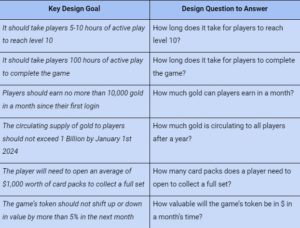In our previous article on how to manage complexity in Machinations, we delved into the effective strategy of segmenting models as a means to manage complex projects using Machinations. Expanded on that concept, this article aims to guide you through the critical decisions of what (and what not) to model and how the right design questions can lead to more efficient models.
Asking Design Questions
Before modeling your economy in a tool like Machinations, you should first ask precisely what question(s) you are aiming to get an answer to. Examples could include:
- How long does it take for players to reach level 10?
- How long does it take for players to complete the game?
- How much gold can players earn in a month?
- How much gold is circulating to all players after a year?
- How many card packs does a player need to open to collect a full set?
- How valuable will the game’s token be in $ in a month’s time?
Notice that each of the above asks a quantitative “how much?” question and specifies some time, effort spent, or an important milestone.
The value of asking questions that follow this pattern is that they are specific and can help you make value judgments about what systems are necessary to model, and which are not.
Note that in the very early stages of building and modeling a game, it is ok not to have specific questions in mind. You may simply want to know what the pace of progression is or how much friction a certain currency sink has. However, as your game design becomes more concrete, so should your conception of the player experience, along with your goals and design questions related to modeling.
The Risks of Asking Vague Questions
Economies and game systems can be complex, which means modeling them can also be complex. You need to set specific goals for what you want to show using your models to avoid putting too much time, effort, and detail into them.
The objective of modeling is not to produce the perfect model that works exactly like the real system. Rather, it is to get the answers you need as quickly as possible and with an acceptable degree of accuracy.
For instance, if the objective of the model is to find out how many card packs a player needs to open before they can collect a full set of cards, there is no need to model how the player obtains those cards or how often. Your question is how many card packs are needed to complete the set, not how long it takes to complete the set.
Naturally, the latter question is also one a designer might want to know. However, it is oftentimes easier and more sustainable to build multiple smaller models, each one designed to answer a specific question.
Supporting Design Goals
For mature games companies, economy designers and data scientists will ask and act on questions that tell them whether certain key design goals or key performance indicators (KPIs), are being met.
For each of the example design questions from the previous section, the following example design goals could have motivated them:

Aligning your design questions with your key design goals will help further in focusing your modeling efforts, especially in teams with multiple designers. Keep in mind that your questions should be precise and quantitative, in order to avoid putting too much time and effort in the modeling process. The right questions lead to enhanced efficiency of the game development process, facilitating more informed decisions and building successful game experiences.


